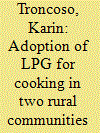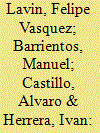| Srl | Item |
| 1 |
ID:
168650


|
|
|
|
|
| Summary/Abstract |
In 2011, a government initiative provided Liquefied Petroleum Gas (LPG) stoves and cylinders to almost 1000 rural families in Chiapas, Mexico. In 2017, the Pan-American Health Organization (PAHO) conducted an evaluation of cooking practices among the beneficiaries of these stoves.
|
|
|
|
|
|
|
|
|
|
|
|
|
|
|
|
| 2 |
ID:
171393


|
|
|
|
|
| Summary/Abstract |
Evidence from south-central Chile shows that the concentration limits for PM10 and PM2.5, defined by both the World Health Organization and national standards, are systematically exceeded, affecting approximately 10 million people. Among the sources of this pollution, firewood use accounts for the largest share. This study assesses whether consumers value environmental, social, and legal attributes associated with the firewood certification programs. We used a discrete choice model based on a sample of 500 households. According to our results, the price premium for certified firewood is about 10% in the most likely scenario, with those attributes closely related to private benefits having a higher value, compared to those of social benefits. We identify significant heterogeneity among respondents belonging to two different consumer classes: 1) those who are less price sensitive and are willing to pay for attributes related to certification; 2) those who are sensitive to prices and are not willing to pay for attributes related to certification. Since the second class includes about 46% of the sample, the implementation of certification programs could be jeopardized. Therefore, knowing this information helps us determine whether a certification system can foster the firewood industry transition to a more sustainable model.
|
|
|
|
|
|
|
|
|
|
|
|
|
|
|
|